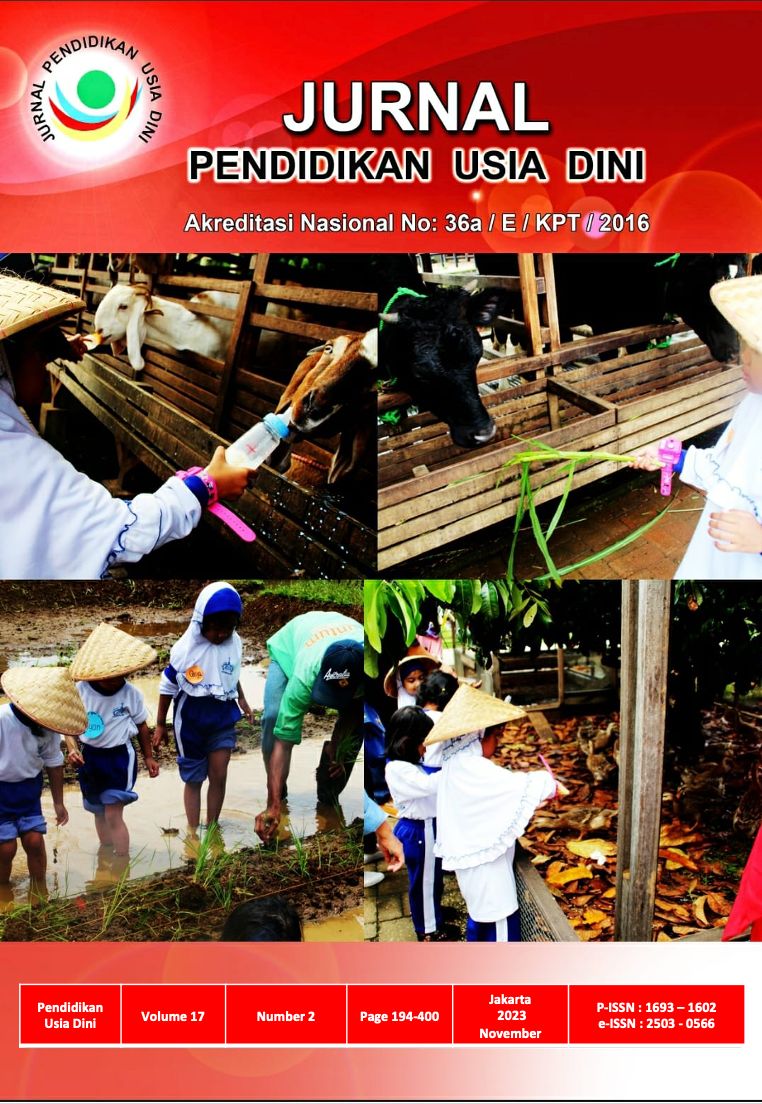Learning Differentiation in ECE Based on Sensing, Thinking, Intuiting, Feeling and Instinct (STIFIn) Intelligence Test Results
DOI:
https://doi.org/10.21009/JPUD.172.10Abstract
In managing learning, teachers need information to meet children's different learning styles and interests. Recognizing children's intelligence from an early age can be determined through the Sensing, Thinking, Intuiting, Feeling, and Instinct Intelligence Test (STIFIn). This is useful for knowing the child's learning style, characteristics, and interests so that it can be said to be suitable for carrying out differentiated learning based on the child's characteristics. This research aims to identify children's interests and talents to help provide an overview of the potential components of each child's character and solutions for handling problematic children. The method used is a descriptive qualitative case study type with an inductive deductive pattern. The research results show that teachers can use the STIFIn test results as a basis for creating a learning environment that suits children's needs based on the characteristics recognized in each child, through predetermined differentiation of strategies, media, and evaluation of learning in early childhood. implemented to support development. early childhood according to their needs and potential.
Keywords: learning differentiation, early childhood, STIFIn intelligence test
References:
A. Langelier, C., & Diane Connell, J. (2005). Emotions And Learning: Where Brain Based ReseArch And Cognitive-Behavioral Counseling Strategies Meet The Road. Rivier College Online Academic, 1.
A. Muir, R., Howard, S. J., & Kervin, L. (2024). Supporting early childhood educators to foster children’s self-regulation and executive functioning through professional learning. Early Childhood Research Quarterly, 67(2), 170–181. https://doi.org/https://doi.org/10.1016/j.ecresq.2023.12.001
Abramczyk, A., & Jurkowski, S. (2020). Cooperative learning as an evidence-based teaching strategy: what teachers know, believe, and how they use it. Journal of Education for Teaching, 46(3), 296–308. https://doi.org/https://doi.org/10.1080/02607476.2020.1733402
Aisyah, N., & Sholehatun mahdia. (2023). Penerapan Metode STIFIN Dalam Memahami Gaya Belajar Siswa. Pedagogika, 4(1), 29–45. https://doi.org/10.37411/pedagogika.v14i1.2202
Alindra, A. L. (2018). Kajian Aksiologi Metode STIFIn dalam Pemetaan Mesin Kecerdasan Manusia. Titian Ilmu: Jurnal Ilmiah Multi Sciences, 10(2), 64–73. https://doi.org/10.30599/jti.v10i2.206
Astuti, I., & Afendi, A. R. (2022). Implementation of Differentiated Learning Through Play Activities in Early Childhood. EduLine: Journal of Education and Learning Innovation, 2(3), 358–365. https://doi.org/10.35877/454ri.eduline1264
Bauera, J., Gartmeier, M., Wiesbeck, A. B., Moeller, G. E., Karsten, G., Fischer, M. R., & Prenzel, M. (2018). Differential learning gains in professional conversation training: A latent profile analysis of competence acquisition in teacher-parent and physician patient communication. Learning and Individual Differences, 61(1), 1–10. https://doi.org/https://doi.org/10.1016/j.lindif.2017.11.002
Creswell, J. W. (2014). Research Design, Qualitative, Quantitative And Mixed Methods Approaches (Fourth Edi). SAGE Publication.
Gray, R. (2020). Comparing the constraints led approach, differential learning and prescriptive instruction for training opposite-field hitting in baseball. Sychology of Sport & Exercis, 51, 10179. https://doi.org/https://doi.org/10.1016/j.psychsport.2020.101797
Henz, D., & Schöllhorn, W. I. (2019). Differential Training Facilitates Early Consolidation in Motor Learning. Frontiers in Behavioral Neuroscience, 10, 199. https://doi.org/10.3389/fnbeh.2016.00199
Herwina, W. (2021). Optimalisasi Kebutuhan Murid Dan Hasil Belajar Dengan Pembelajaran Berdiferensiasi. Perspektif Ilmu Pendidikan, 35(2), 175–182. https://doi.org/10.21009/pip.352.10
Lestariningrum, A. (2022). Konsep Pembelajaran Terdefirensiasi Dalam Kurikulum Merdeka Jenjang PAUD. Semdikjar 5, 5, 179–184.
Marlina. (2020). Strategi Pembelajaran Berdiferensiasi di Sekolah Inklusi. CV Afifa Utama.
Mulyawati, Y., Zulela, M., & Edwita, E. (2022). Differentiation Learning to Improve Students Potential in Elementary School. Pedagonal : Jurnal Ilmiah Pendidikan, 6(1), 68–78. https://doi.org/10.55215/pedagonal.v6i1.4485
Mumpuniarti, Mahabbati, A., & Handoyo, R. R. (2023). Diferensiasi Pembelajaran. UNY Press.
Ngaisah, N. C., Munawarah, & Aulia, R. (2023). Perkembangan Pembelajaran Berdiferensiasi Dalam Kurikulum Merdeka Pada Pendidikan Anak Usia Dini. Bunayya : Jurnal Pendidikan Anak, 9(1), 1–25. https://doi.org/http://dx.doi.org/10.22373/bunayya.v9i1.16890
Pasmawati, H. (2019). Bimbingan Karir Farid Poniman dan Relevansinya dengan Konsep Islam: Telaah STIFIn Test. Jurnal Ilmiah Syi’ar, 19(2), 182. https://doi.org/10.29300/syr.v19i2.2476
Poniman, F. (2016). 9 Personaliti Genetik (Pikacinta (ed.)). Yayasan STIFIn. https://stifinfamily.com/blog/
Poniman, F., & Andi Mangussara, R. (2012). STIFIn Palugada (H. Wahyu Santoso (ed.)). STIFIn Institute.
Santos, S., Coutinho, D., Gonçalves, B., Schöllhorn, W., Sampaio, J., & Leite, N. (2018). Differential Learning as a Key Training Approach to Improve Creative and Tactical Behavior in Soccer. Research Quarterly for Exercise and Sport, 89(1), 1–14. https://doi.org/10.1080/02701367.2017.1412063
Schöllhorn, W. I. (2016). Invited commentary: Differential learning is different from contextual interference learning. Human Movement Science, 47, 240–245. https://doi.org/https://doi.org/10.1016/j.humov.2015.11.018
Setiawan, A., Zebua, R. S. Y., & Sunarti, S. (2021). Strategi Pendidikan Karakter Anak Usia Dini Menggunakan Perangkat Kepribadian Genetik STIFIn. Jurnal Obsesi : Jurnal Pendidikan Anak Usia Dini, 6(3), 1859–1872. https://doi.org/10.31004/obsesi.v6i3.1860
Siti Kurniasih, E., & Priyanti, N. (2023). Pengaruh Pendekatan Pembelajaran Diferensiasi Terhadap Kemampuan Literasi Baca, Tulis dan Numerasi Pada Anak Usia Dini. Jurnal Ilmiah Potensia, 8(2), 398–408. https://doi.org/https://doi.org/10.33369/jip.8.2.398-498
Sitorus, P., Simanullang, E. N., Manalu, A., Laia, I. S. A., Tumanggor, R. M., & Nainggolan, J. (2022). Effect of Differentiation Learning Strategies on Student Learning Results. Jurnal Penelitian Pendidikan IPA, 8(6), 2654–2661. https://doi.org/10.29303/jppipa.v8i6.2114
Somadayo, S., & Kurniawan, H. (2023). The Role of Teacher Professionalism in Learning Differentiation of Independent Learning for Students. Jurnal Pendidikan, Sosial, Dan Agama, 15(1), 275–284. https://doi.org/10.37680/qalamuna.v15i1.2394
Downloads
Published
How to Cite
Issue
Section
License
JURNAL PENDIDIKAN USIA DINI work is licensed under a Creative Commons Attribution 4.0 International License. (http://creativecommons.org/licenses/by/4.0/)





